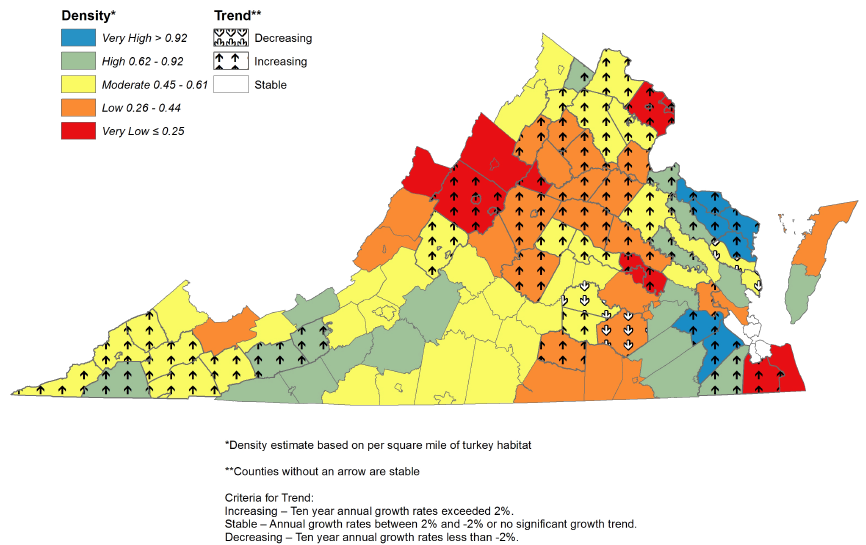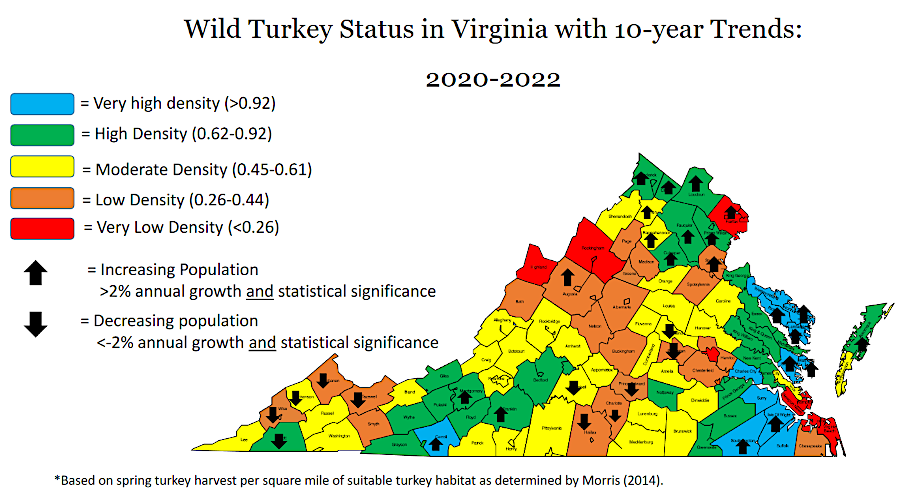

turkey hunting seasons are adjusted annually, based on population estimates and management objectives
Source: Virginia Department of Wildlife Resources, Wild Turkey Population Status, 2016-2017 and Wild Turkey Population Status, 2020-2022


turkey hunting seasons are adjusted annually, based on population estimates and management objectives
Source: Virginia Department of Wildlife Resources, Wild Turkey Population Status, 2016-2017 and Wild Turkey Population Status, 2020-2022
Wild turkeys depend upon wooded areas for food and shelter. Habitat change, primarily the clearing of forests for farming and the grazing of pigs and other domesticated animals in the woods, reduced the wild turkey population in Virginia to its lowest levels between 1880 to 1910. The population recovered in part through state action to limit hunting.
Market hunting, where an unlimited number of birds could be killed and sold to customers, was prohibited in 1912. Just passing a law did not stop the practice, but enforcement began with the creation of the Game Department (now Virginia Department of Game and Inland Fisheries) in 1916.
There was still sufficient habitat for wild turkeys at that time, but not enough local birds to repopulate it. Starting in 1929, the state raised wild turkeys at game farms and released them back into the wild. However, birds raised inside a pen lacked the skills to survive in the wild, without food was delivered on a regular basis and where predators were looking for a meal. Though it was relatively inexpensive to raise turkeys on a farm, release of 22,000 birds failed to establish naturally-breeding populations. The game farm strategy was finally discontinued in 1955.
The alternative, trapping native wild turkeys and relocating them to areas with "empty" habitat, was far more successful. Between 1955 to 1993, 900 turkeys were trapped and moved, primarily to Southwestern Virginia and Tidewater. Trapping and relocating wild birds did re-establish turkeys across the state.
The state defined wild turkeys as a game animal over a century ago, and hunters financed the turkey recovery efforts through the purchase of hunting licenses. By defining different hunting seasons and bag limits (the number of birds a hunter can kill in a day/season) in different areas of the state, the Virginia Department of Game and Inland Fisheries maintains the desired population.

wild turkeys feed on grasshoppers
Source: National Park Service / Jane Gamble, Wild Turkeys
Hunting pressure can be reduced if bad weather, low natural acorn production, or other circumstances indicate a low population, and increased once population levels have increased.
A research study in 1989 to 1994 helped to clarify the impacts of hunting and natural mortality of wild turkeys. Of the half of the population that did not survive a year, natural mortality (including disease and predation) reduced the population by about one-third and hunters harvested around 15%. Fall hunting appears to reduce the population more than spring hunting, which was first authorized in 1962.
During the study, about 50% of the population survived each year. Though turkeys lay 9-13 eggs in a nest, in Virginia the successful reproduction rate was low. Only one-third of the hens successfully hatched their clutch of eggs, and only half of those clutches survived for a month and increased the local population.1
Today, the population of wild turkeys in Virginia has climbed from just several hundred in the 1930's to 180,000.2
Source: Virginia Department of Wildlife Resources, True Wildlife Crime: Exposing a Prolific Turkey Poacher
Source: Virginia Department of Wildlife Resources, True Wildlife Crime: Exposing a Prolific Turkey Poacher